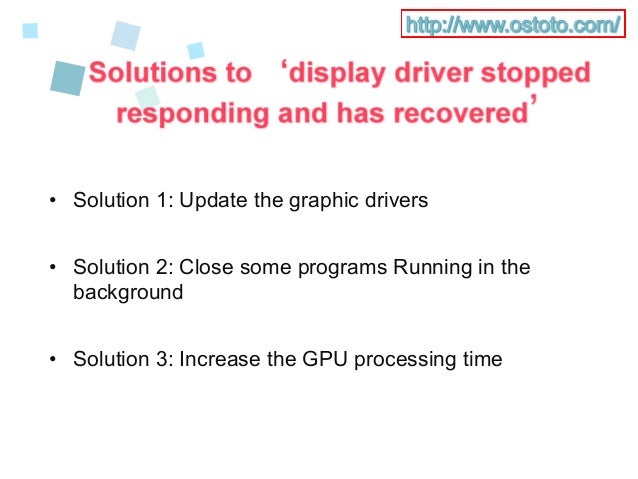

- #Fix display driver stopped responding windows 10 install#
- #Fix display driver stopped responding windows 10 drivers#
- #Fix display driver stopped responding windows 10 update#
- #Fix display driver stopped responding windows 10 Pc#
Then select Windows Update from the left menu bar. #Fix display driver stopped responding windows 10 install#
No matter which build you are on, it is always recommended to download and install these pending updates, which could be done as follows: These updates are even more frequent if you are on Insider Preview builds. Windows regularly releases updates that tends to fix underlying bugs, improves performance and enhances security.
#Fix display driver stopped responding windows 10 Pc#
Finally, restart the PC and check if it fixes the “Display driver stopped responding and has recovered” error on Windows 11. Now double click to open it, type in 8 in the Value Data and hit OK. Now right-click on GraphicsDriver and select New > DWORD (32-bt) Value. Copy-paste the below location in its address bar: Computer\HKEY_LOCAL_MACHINE\SYSTEM\CurrentControlSet\Control\GraphicsDrivers Open Run via Windows+R shortcut, type in the below command and hit Enter. So you should consider increasing the processing time that has been allocated to the GPU. The GPU might not be getting enough time to process the request and reinitate a new process, and that might be the reaosn why the TDR is noticing frequent crashes with the GPU. Now check if the “Display driver stopped responding and has recovered” error on Windows 11 has been fixed or not. After that, select Adjust for Best Appearance, click Apply > OK. Then click on the Settings button next to Performance. It will launch the System Properties dialog box, go to its Advanced tab. Fortunately, we don’t have to do much in this regard as Windows comes with built-in plan corresponding to this requirement. So the best bet is to have most of these features disabled and only enable the most important ones. However, the thing is that most of these features are enabled by default, and this might take a toll on your GPU. Set it to Off under both the On battery and Plugged in state and click OK to save it.Īnimations, Shade and Translucency Effects, Shadow, Thumbails, Smooth Edges, you name it and Windows have it all under its disposal. Then expand the PCI Express followed by Link State Power Management. Now click on Change Plan Settings followed by Change advanced power settings. Then type in powercfg.cpl and hit Enter. Bring up the Run dialog box via Windows+R shortcut keys. So the best approach is to disable the Link State Power Management, which could be done as follows: By default, the Link State will opt for the Maximum Power Savings, which might not be the best mode in the case scenario, and neither is the Moderate Power Savings. On the other hand, in the Maximum Power Savings, the power savings are greater, but the time to recover from the Sleep state (latency) is much longer. If you opt for Moderate Power Savings mode then the power savings will be less, but the time to recover from the Sleep state (Latency) is much shorter. It takes into consideration two factors: Power Savings and Latency and then select the appropriate mode. 
The Link State Power Management uses the PCI-E Specification to determine the power management cycle of your CPU.
Check if it fixes the “Display driver stopped responding and has recovered” error on Windows 11.įIX 3: Turn Off Link State Power Management. Now go to Power Mode and set it to Best Performance. Then select System and go to Power and Battery. Bring up the Settings menu via Windows+I shortcut keys. However, in some instances, the GPU might need some additional power, and for that, you need to give a higher priority to the Performance domain in comparison to saving the battery. By default, it will be set to Balanced, thereby maintaining an equilibrium among both these factors. 
The Power Mode feature lets the OS determines whether you give higher priority to the performance or battery.
Once done, restart your PC and then check if it fixes the “Display driver stopped responding and has recovered” error on Windows 11. #Fix display driver stopped responding windows 10 drivers#
Windows will now search online for the available drivers and would subsequently download and install them.Then choose Search automatically for drivers.Then expand the Display Adapter section, right-click on your graphics card, and select Update Drivers.Press the Windows+X shortcut keys and select Device Manager from the menu that appears.So your first course of action should be to ud[te these drivers to the latest version, which could be done as follows: Using old or outdated graphics drivers are usually the root cause of display-related issues.







 0 kommentar(er)
0 kommentar(er)
